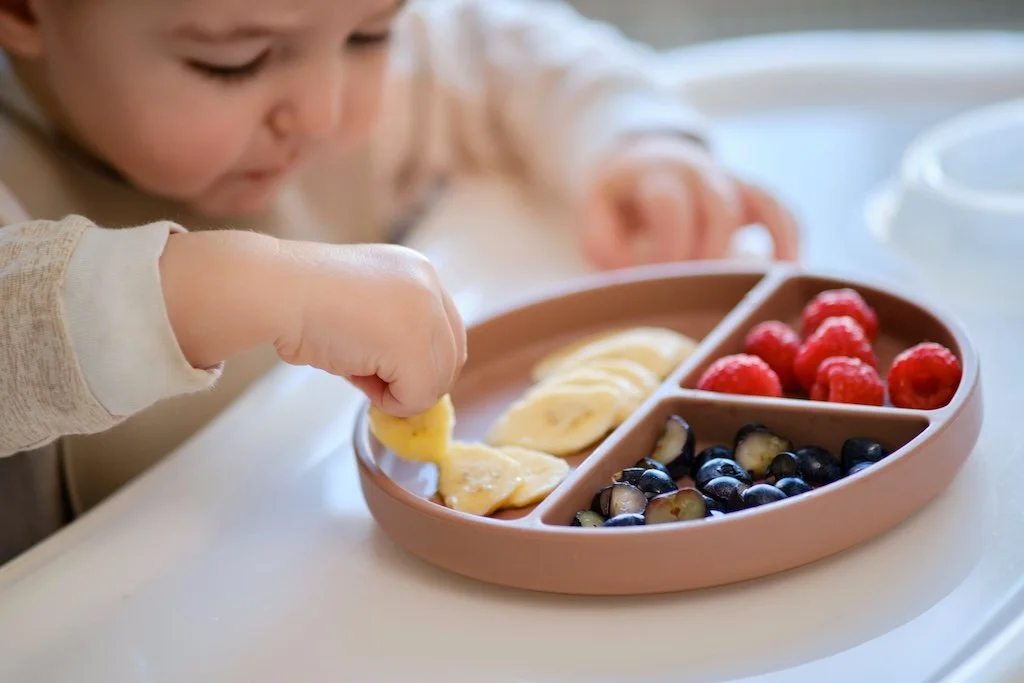8 High-Calorie Foods for Toddlers
-
When toddlers need extra calories for growth, choosing nutrient-rich, wholesome foods can make all the difference. This guide highlights simple, balanced options that provide healthy fats, proteins, and essential nutrients — along with easy ways to serve them.
What are high-calorie foods for toddlers?
Nutrient-dense foods like avocados, nut butters, cheese, eggs, oats, bananas, sweet potatoes, and whole milk yogurt offer calories that support growth, energy, and brain development.
Why do some toddlers need extra calories?
Factors like high energy needs, picky eating, or medical challenges can make it hard for children to meet their nutritional goals through meals alone. High-calorie, whole foods help fill those gaps naturally.
How can parents boost calories at mealtime?
Incorporate healthy fats (like avocado and nut butter), add cheese or yogurt to favorite foods, and offer soft, easy-to-eat options that toddlers enjoy. Small changes can make a big impact on daily nutrition.
What are the benefits of nutrient-rich foods?
These foods provide essential vitamins and minerals for bone strength, digestive health, brain development, and immune support—all while helping maintain steady growth.
Why work with a dietitian?
Every child’s needs are unique. A pediatric dietitian can help families create balanced meal plans and determine if additional oral nutrition support is needed.
What does Sentido Health offer?
Sentido Health’s team of pediatric dietitians and clinicians helps families find the right nutritional solutions for medically complex children—offering personalized guidance, education, and compassionate care.
If your child’s healthcare provider has recommended increasing their calorie intake, you’re not alone. Many toddlers, especially those who are active, selective eaters, or medically complex, may need a little extra support to meet their nutritional needs.
Whether your goal is healthy weight gain, supporting growth after illness, or simply ensuring your toddler stays nourished and energized, adding high-calorie foods can make a big difference.
The key is focusing on nutrient-rich foods that deliver calories and essential vitamins, minerals, and protein for growth and development. With the right foods and a few creative strategies, you can help your toddler eat (or drink) more calories without mealtime stress.
Why Toddlers Might Need More Calories
Every child’s needs are unique, and their diet can have a significant impact on their overall health and development. Therefore, it is essential that calorie intake is met daily. Toddlers between the ages of 2 and 4 typically require between 1,000 and 1,400 calories per day for girls and between 1,000 and 1,600 calories per day for boys. Some children may need more calories if they:
Are recovering from illness or surgery
Have increased energy demands due to a medical condition
Struggle with feeding difficulties or low appetite
Have higher metabolic needs
Are underweight or not gaining weight as expected
Always talk to your child’s pediatrician or registered dietitian before making changes to their diet. They can help identify the right calorie range and ensure nutritional balance.
For more information on recommended calorie intake for toddlers, read this blog from the Mayo Clinic.
Tips to Help Your Toddler Eat More Calories
Adding calories doesn’t have to mean larger portions. The goal is calorie density, packing more nutrition into each bite or sip. Here are a few practical ways to do that:
1. Offer Small, Frequent Meals
Many toddlers do better with five to six small meals or snacks per day. Grazing throughout the day helps ensure steady energy and makes it easier to fit in extra calories.
2. Mix in Healthy Fats
Fats are the most calorie-dense nutrient, offering more than twice the calories per gram as protein or carbohydrates. Try:
Stirring olive oil or avocado oil into pasta, mashed potatoes, or sauces
Spreading nut butters (if age-appropriate and no allergies) on fruit, toast, or crackers
Mixing butter, cream cheese, or full-fat yogurt into warm cereals or vegetables
3. Make Every Bite Count
If your toddler eats small portions, make sure each bite is rich in calories and nutrients. Add cheese to scrambled eggs, nut butter to oatmeal, or powdered milk to soups and smoothies. For picky eaters, try blending protein-rich foods into familiar favorites. For example, mix beans into soups, add ground meat to pasta, or blend tofu into smoothies.
4. Use Smoothies and Shakes
Blending foods is an easy way to combine calories and nutrients in one meal. Use milk, yogurt, nut butter, avocado, and fruit to create high-calorie smoothies your child will love.
If your child is struggling to gain weight due to picky eating, read our blog “10 Ways to Encourage Picky Eaters”.
8 High Calorie for Toddlers
When your toddler needs a boost in calories, it’s best to focus on nutrient-dense foods that fuel growth and development. The following options are packed with healthy fats, protein, and essential nutrients, all while being easy to prepare and serve in toddler-friendly ways.
1. Avocado
Creamy, mild, and easy to mash, avocado is one of the most toddler-friendly high-calorie foods. One fruit offers roughly 240 calories, along with heart-healthy fats that support brain development.
Why It’s Great
Packed with vitamins C, E, and K, as well as potassium and magnesium.
Rich in fiber, which supports digestive health.
Vitamin K helps promote strong bones and prevent osteoporosis.
Ways to Serve It
Cut into wedges for a simple finger food.
Mash into a quick “guacamole” with cottage cheese.
Blend into smoothies or mix into sauces for pasta or rice dishes.
2. Nut Butters
Peanut, almond, cashew; whichever you choose, nut butters are an easy way to add calories, protein, and healthy fats to your toddler’s meals.
Why They’re Great
High in fiber and protein to support balanced energy and blood sugar.
Contain calcium and magnesium for bone health.
Rich in vitamins E and B3, which benefit skin and eye health.
Extremely versatile and easy to mix into other foods.
Ways to Serve Them
Blend into yogurt, oatmeal, smoothies, or purees.
Spread a thin layer onto fruit slices or whole-grain crackers for a satisfying snack.
3. Full-Fat Cheese
Cheese adds calories, protein, and flavor to almost any meal — making it one of the easiest high-calorie foods for toddlers.
Why It’s Great
Offers calcium, protein, and healthy fats for strong bones and steady growth.
Provides key nutrients like vitamin D and phosphorus.
Melts easily or can be served as bite-sized snacks.
Ways to Serve It
Melt over eggs, pasta, or vegetables.
Offer cheese sticks or cubes as snacks.
Mix cottage cheese with fruit or avocado for a calorie boost.
For dairy-sensitive kids, try lactose-free or nut-based cheese alternatives.
4. Eggs
Eggs are a powerhouse of nutrition, soft, quick to cook, and full of nutrients essential for brain and body development. One large egg provides about 70 calories and 6 grams of protein.
Why They’re Great
High-quality protein and healthy fats for growth.
Contains choline, which supports brain development.
Easily incorporated into meals and snacks.
Ways to Serve Them
Serve scrambled or hard-boiled as finger foods.
Mix into pancakes, muffins, or fried rice.
Add to casseroles or veggie dishes.
If your toddler dislikes plain eggs, try adding cheese or mixing them into familiar meals like pasta.
5. Oats
Oats are a wholesome source of complex carbohydrates, providing long-lasting energy and fiber to support healthy digestion.
Why They’re Great
High fiber content helps regulate digestion and prevent constipation.
Contain beta-glucan, which supports healthy cholesterol levels.
Gentle on the stomach and promote growth of good gut bacteria.
Ways to Serve Them
Make calorie-rich oatmeal with whole milk, cottage cheese, or cream and fruits like bananas or avocado.
Bake low-sugar oatmeal cookies with nut butter.
Prepare overnight oats with chia seeds, fruit, and nut butter for a convenient breakfast.
6. Bananas
Naturally sweet and easy to digest, bananas are a great base for adding calories when paired with higher-fat foods.
Why They’re Great
Provide soluble fiber to support digestion and regularity.
Contain potassium for strong bones and vitamin A for healthy vision.
Mash easily into sauces, spreads, or oatmeal.
Ways to Serve Them
Slice and serve with cottage cheese, oatmeal, or cereal.
Dip in whole milk yogurt and freeze for a summer treat.
Spread nut butter on banana slices or wrap in a tortilla for a quick snack.
Bake into oat muffins or breakfast cookies.
7. Sweet Potatoes
Naturally sweet and nutrient-packed, sweet potatoes are an excellent source of energy for growing toddlers.
Why They’re Great
High in vitamin C to help the immune system fight infections.
Provide vitamin B6, important for brain development.
Complex carbohydrates support sustained energy and growth.
Ways to Serve Them
Cook until soft and top with melted cheese.
Mash into a puree and mix with beans or vegetables.
Cut into cubes and roast for easy finger foods.
8. Whole Milk Yogurt
Creamy and versatile, whole milk yogurt is an easy way to pack in calories, protein, and probiotics to support digestive health.
Why It’s Great
Provides protein and fat to support growth.
Contains probiotics for gut health and digestion.
Full-fat versions help absorb fat-soluble vitamins like A and D.
Ways to Serve It
Mix with fruit, oats, or granola for breakfast or snacks.
Blend into smoothies for a creamy texture.
Use as a dip for fruit or soft crackers.
Freeze into popsicles for a fun, nutritious dessert.
Considerations Before Changing Your Child’s Diet
While adding calories can help support growth and energy, it’s important to do so safely and intentionally. Here are a few things to keep in mind:
1. Always Consult a Healthcare Professional
Before making major changes, talk to your child’s pediatrician or registered dietitian. They can assess your child’s growth, caloric needs, and overall nutrition to create a personalized plan.
2. Avoid Too Many Empty Calories
Focus on nutrient-rich calories from whole foods rather than sugary snacks or drinks. High-calorie foods should also contain vitamins, minerals, protein, and healthy fats.
3. Watch for Allergies or Intolerances
When adding new foods or formulas, introduce one at a time and monitor any reactions, especially if your child has food sensitivities.
4. Support Mealtime Positivity
Avoid pressuring your toddler to eat more than they want. Encourage exploration, offer variety, and make mealtime a positive experience.
5. Track Growth and Adjust
Regular check-ins with your pediatrician help ensure your child is gaining weight and growing appropriately. Your healthcare provider can also help adjust calorie targets as your child grows.
Your Nutritional Support Partner
Supporting your toddler’s calorie needs doesn’t have to be stressful or complicated. Remember, every child is different. Some may need only small adjustments, while others may benefit from more structured nutritional support.
If your child still struggles to meet their calorie needs through food alone, nutritional supplements or high-calorie formulas may be helpful. At Sentido Health, our dietitians and clinical team work closely with families to find the best solutions for each child’s nutritional goals. Be sure to talk with your healthcare provider before introducing any new formula or supplement.
Want to learn more? Read our blog, “High-Calorie Formulas and Nutritional Drinks”, to discover whether an oral formula might be right for your child.



